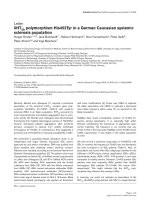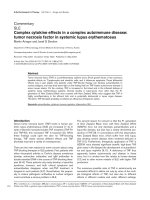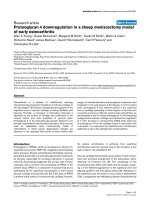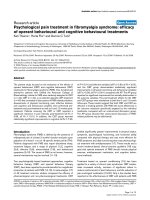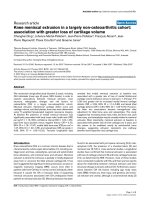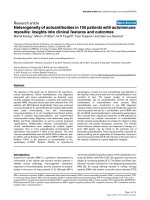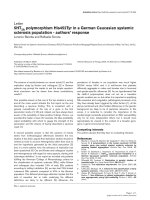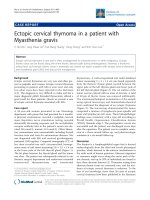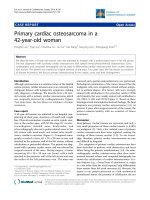Báo cáo y học: "Premature ovarian failure in a woman with a balanced 15;21 translocation: a case report" ppt
Bạn đang xem bản rút gọn của tài liệu. Xem và tải ngay bản đầy đủ của tài liệu tại đây (261.11 KB, 2 trang )
CAS E RE P O R T Open Access
Premature ovarian failure in a woman with a
balanced 15;21 translocation: a case report
Sayedehafagh Hosseini
*
, Marzieh Vahid Dastjerdi, Zahra Asgari and Haydeh Samiee
Abstract
Introduction: A case of premature ovarian failure with concomitant findings of Robertsonian translocation
between 15 and 21 chromosomes is reported here. The aforementioned karyotypic aberration has not been
reported in the context of premature ovarian failure to date.
Case presentation: We present a case of premature ovarian failure in a 27-year-old infertile Kurdish Iranian woman
with a Robertsonian 15;21 translocation.
Conclusions: The diagnosis of premature ovarian failure of unknown etiology, but with karyotypic evidence of a
balanced autosomal translocation, suggests the possible role of autosomal genes in the pathogenesis of ovarian
follicular attrition.
Introduction
A significant family history of early menopause is found in
about 5% of cases of premature ovarian failure (POF) [1].
To determine the underlying basis of POF, genetic causes
with a range of proposed loci are currently under investi-
gation. Out of every 900 babies, one is born with a Robert-
sonian translocation (cited for the first time in 1964 by
Gustavsson and Ingemar), showing that this translocation
is the most common, significant and recurrent structural
rearrangement known in man.
Case presentation
Our patient, a 27-year-old Iranian Kurdish woman
under evaluati on for infertility, had experienced second-
aryamenorrheafromtheageof24.Shehadreceived
hormonal replacement for the p ast three ye ars, which
resulted in cyclical bleeding, but she remained anovula-
tory. The Karyotype of the proband showed a transloca-
tion between chromosomes 21 and 15:45,XX,t (21;15).
She had regular menstruation cycles from the age of 13
until 21 years of age. Her height and weight were in the
90th and 50th percentiles, respectively, and she had a
body mass index of 21 kg/m
2
.Herarmspantoheight
and upper to lower segment ratios were both normal.
With regard to her pubertal status, she was Tanner V for
pubic hair and Tanner IV for breast growth. Her genitalia
were normal and she had no virilized or dysmorphic fea-
tures. Her intellectual capacity was in the normal range
and she had a full-time career as a teacher.
No positive family history was noted regarding prema-
ture menopause, infertility and subfertility, smoking, che-
motherapy, radiation or autoimmune diseases. The
results of cytogenetic and molecular studies using poly-
merase chain reaction (PCR) techniques for fragile ×
mutations or premutations were negative.
Serum anti-thyroid, anti-ovarian and anti-adrenal anti-
bodies were absent. Her estradiol level was 32 pg/mL and
serum anti-mullerian hormone was 0.34 μg/L. She denied
any history of pelvic inflammatory or sexually trans-
mitted diseases. Additionally, no s ign of pelvic surgery
was observed. An ultrasound examination of the pelvis
revealed a normal uterus measuring 68 × 29 mm, and the
right and left ovaries were 24 × 20 mm and 23 × 21 mm,
respectively. One selectable antral follicle (4.6 mm) was
also seen.
A hysterosalpingogram (performed at the infertility
center’s routine request) confirmed normal uterine and
tubal anatomy. Hormonal evaluation showed elevated
follicle stimulating hormone (FSH) (25IU/mL) and leu-
tenizing hormone (LH) (22IU/mL) levels. Her thyroid
stimulating hormone (TSH), testosterone and prolactin
levels were within normal limits.
* Correspondence:
Arash University Hospital, Department of Obstetrics & Gynecology, Tehran
University of Medical Sciences, Tehran, Iran
Hosseini et al. Journal of Medical Case Reports 2011, 5:250
/>JOURNAL OF MEDICAL
CASE REPORTS
© 2011 Hosseini et al; licensee BioMed Central Ltd. This is an Open Access articl e distributed under the terms of the Creative Commons
Attribution License (http://creativecommons .org/licenses/by/2.0), which permits unrestricted use, distribution, and reproduction in
any medium, provided the original work is properly cited.
Discussion
Premature ovarian failure is a common occurence in the
context of balanced X: autosomal translocations. Chro-
mosomal imbalan ce can increase oocyte atresia, because
after m eiosis is initiated, × inactivation is not operative
in germ cells [2].
It is possible that translocations such as X monosomy
(Turner syndrome) lead to premature ovarian failure by
causing aberrations in pairing or X inactivation during
folliculogenesis [2] rather than interrupting specific
genes that are important in ovarian development.
The most common Robertsonian translocations appar-
ently have the same breakpoints and arise mainly during
oogenesis, predominantly during meiosis [3]. During
chromosomal pairing and condensation, failure at
checkpoints (specific locations along chromosomes) pro-
vokes germ cell death. Chromosome dynamics may be
sensitive to structural changes, while modification by
translocations might provoke apoptosis at meiotic
checkpoints [2]. Robertsonian translocation between
chromosomes 13 and 14 has recently been reported in a
19-year-old Japanese woman with secondary amenor-
rhea [4].
There are four autosomal translocations in women
with premature ovarian failure: 46 XX,t (2;11), 45,XX,t
(13;14) [4], 46,XX,t (2;15) [1,5], and mosaicism 45,XX,
ROB (13;21)(q10;q10)/46,XX in 55% of the cells [6]. An
approximately five-years earlier menopause has pre-
viously been described with trisomy 21 [7]; therefore, a
critical balance of ‘determinant’ genes within this chro-
mosome may influence reproductive lifespan.
Conclusions
As trisomy 21 is described in association with reduced
ovarian reserve [3], the present translocation risk for
such an eventuality is particularly escalated. In addition,
given the reduced ovarian reserve, although fertility
prognosis with these karyotype gametes remains subop-
timal this feature has an increased risk of conceiving a
fetus with trisomy 15 and monosomy 21 or 15. To mini-
mize the risk of fet al aneuploidy, donor egg in vitro fer-
tilization (IVF) provides a reassuring alternative.
Based on our medi cal research of English and Persian
language articles, there seems to be no previously pub-
lished report identifying a Robertsonian translocation
between 15 and 21 chromosomes accompanied by either
early menopause or reduc ed ovarian reserve. This find-
ing merits widespread exploration to find whether 15;21
translocation results in disruption of ovarian folliculo-
genesis or follicular atresia and an early decline in ovar-
ian follicles. Some aspects of this case will be cla rified
after the Human Genome Project is complete.
Consent
Written informed consent was obtained from the patient
for publication of this case report and any accompany-
ing images. A copy of the written c onsent is available
for review by the Editor-in-Chief of this journal.
Acknowledgements
We acknowledge our colleagues’ efforts in Shariati Infertility Center.
Authors’ contributions
All authors analyzed and interpreted our patient’s data. The first author was
the major contributor to writing the manuscript. All authors read and
approved the final manuscript.
Competing interests
The authors declare that they have no competing interests. The authors
have fulfilled all conditions required for authorship. The authors have no
previous publications similar to this study.
Received: 25 May 2010 Accepted: 29 June 2011 Published: 29 June 2011
References
1. Burton KA, Van EECC, Kim Purcell, Winship Inger, Shelling AN: Autosomal
translocation associated with premature ovarian failure. J Med Genet
2000, 37:e2.
2. Schlessinger D, Herrera L, Crisponi L, Mumm S, Percesepe A, Pellegrini M,
Pilia G, Forabosco A: Genes and translocations involved in POF. Am J Med
Genet 2002, 111:328-333.
3. Kummer N, Martin JR, Pal L: Diminished ovarian reserve in a woman with
a balanced 13;21 translocation. Fertil Steril 2009, 91:931.
4. Kawano Y, Narahara H, Matsui N, Miyakawa I: Premature ovarian failure
associated with a Robertsonian translocation. Acta Obstet Gynecol Scand
1998, 77:467-469.
5. Van Montfrans JM, Dorland M, Oosterhuis GJE, Van Vugt JMG, Rekers-
Mombarg LTM, Lambalk CB: Increased concentrations of follicle-
stimulating hormone in mothers of children with Down’s syndrome.
Lancet 1999, 353:1853-1854.
6. Bandyopadhyay R, McCaskill C, Knox-Du Bois C, Zhou Y, Berend SA,
Bijlsma E, Shaffer LG: Mosaicism in a patient with Down syndrome
reveals post-fertilization formation of a robertsonian translocation and
isochromosome. Am J Med Genet 2003, 116A:159-163.
7. Cosgrave MP, Tyrrell J, McCarron M, Gill M, Lawlor BA: Age at onset of
dementia and age of menopause in women with Down’s syndrome. J
Intellect Disabil Res 1999, 43:461-465.
doi:10.1186/1752-1947-5-250
Cite this article as: Hosseini et al.: Premature ovarian failure in a woman
with a balanced 15;21 translocation: a case report. Journal of Medical
Case Reports 2011 5:250.
Submit your next manuscript to BioMed Central
and take full advantage of:
• Convenient online submission
• Thorough peer review
• No space constraints or color figure charges
• Immediate publication on acceptance
• Inclusion in PubMed, CAS, Scopus and Google Scholar
• Research which is freely available for redistribution
Submit your manuscript at
www.biomedcentral.com/submit
Hosseini et al. Journal of Medical Case Reports 2011, 5:250
/>Page 2 of 2
